- info@naturebylennart.com


Experiencing certain natural phenomena can be an experience like nothing else. Witnessing a solar eclipse, for instance, that happened to me in Chile. I still remember it well and it was one of the most special things I have ever seen. Watching an erupting volcano or a roaring tornado also strikes me as one of those unique experiences. Encounters with animals in the wild can evoke a similar feeling. There is a difference between simply seeing an animal and truly experiencing an animal.

Solar eclipse in 2019 in the Atacama Desert: something else! Full story here.
Standing in the middle of a colony of Emperor Penguins in Antarctica is a completely different experience than watching a single Emperor Penguin drift past on a ice floe. Similarly, being among a group of Mountain Gorillas in a country like Uganda is a vastly different experience from seeing the same species from a great distance. The same applies to witnessing the fishing behaviour of brown bears in Alaska, and there are more examples like this. The experience of looking these animals in the eye and observing their natural behavior up close makes it special, and it’s why some people are willing to invest significant time and money in it.
Underwater, too, a niche within ecotourism has developed in this way. Swimming with Whale Sharks, for example, has become quite common in certain places. I had the opportunity to experience this myself in Mexico.

Whale Shark before the coast of Yucatán, Mexico in 2022. Full story here.
In other places, different sharks can be found, such as Great White Sharks and Bull Sharks. In many countries, it’s also possible to swim with dolphins or other remarkable sea creatures, such as manta rays or sunfish.
All these experiences have in common that people are looking for just a little more than simply ticking off a box. Of course, there is nothing wrong with wanting to see as many species as possible. Life requires making choices, and someone who, for example, wants to see as many bird species as possible does not have the luxury of spending several weeks searching for just one species.
I myself am more involved in a combination of both: I enjoy spending a lot of time observing that one special species, but I also try to see as many species as possible when I am in a certain place. What I hadn’t done before was planning a whole trip around an animal I had already seen before. Time to change that!
I was lucky enough to see Blue Whales when I went to Svalbard in 2016. That was my first encounter with the largest animal on Earth. However, I had what I experience with all big whale sightings: I was disappointed by what I was actually able to see of the animal. Usually it’s nothing more than a big blow when it comes up and seeing part of it’s back. When you are lucky you will see the fluke high in the air when the whale dives, but that’s usually about it. To truly see a whale in its entirety as it is: that is a privilege few are granted.

A picture of my first Blue Whale in Svalbard in 2016. For more Svalbard have a look here.
I had decided that I would like to admire the largest animal in the world in its full glory underwater. I remember that when I was in high school, I had already looked for opportunities to do that, but I was disappointed by the amount of money it would cost. It also didn’t seem like a realistic undertaking.
Then, for years, I didn’t really think about seeing a Blue Whale underwater until I suddenly saw a video on Facebook of a Blue Whale underwater. I still remember clearly that this was in the fall of 2019, just after I had returned from Borneo after several months of traveling. I was curious if this was just a very lucky sighting or that perhaps some kind of planning had been involved. So, I wanted to know exactly under what circumstances that sighting had been made.
Further searching using the hashtags led to a location: Timor-Leste. It was a country I had never heard of before. I had heard of Timor at some point because of the armed conflict there (the link with Indonesia, for which we Dutch of course have a certain responsibility, was not far off), but I didn’t know that there was actually a separate country on this island. But it turned out to be the case, and not only that: there was also a dive center there! Aquatica Dive Resort turned out to be located in East Timor. By the way, the word Leste is simply the Portuguese word for East. It is also often used interchangeably, at least that’s how I’ve experienced it.
Timor-Leste was originally a Portuguese colony, creating a distinction from the rest of the archipelago, which was under the rule of my own little country: the Netherlands. Unlike many of their other colonies, the Portuguese held firmly and for a long time onto their position in Timor, but World War II brought a change. After several turbulent years, the Portuguese regained their dominance over this part of the island, and that continued after the independence of Indonesia.
At one point, in 1975, East Timor also declared independence, but this promptly led to an invasion by Indonesia. This was followed by a horrific time for East Timor, marked by what could only be described as genocide with over a 100.000 casualties. Mass killings took place on a large scale, accompanied by all sorts of associated horrific practices. The world initially paid little attention to this. The occupation lasted close to the year 2000, which is an easy year for calculation. Ultimately, East Timor succeeded in becoming an independent country.
It is important to note, however, that these bloody years are not very far in the past, and the entire older generation in East Timor has lived through this themselves. It is imaginable that this has left deep trauma. An interesting fact is that the current president of Indonesia is strongly and verifiably linked to war crimes in East Timor…
I couldn’t resist briefly describing this piece of history. Of course, I have gone through it in a nutshell, but it cannot go unmentioned. In this light, it is also understandable why Timor-Leste is not yet the most well-organized country in the world. The country already started its development with a disadvantage and, with the US dollar as its currency, squeezed in as a relatively small nation between the local superpowers Indonesia and Australia, it also faces challenges on the economic front.
But fortunately, there are indeed hopeful developments, and at least Timor-Leste turned out to be offering something unique: swimming with Blue Whales! That was why the country had caught my attention. Aquatica Dive Resort turned out to be run by Desmond Lee, with whom I had already had a brief chat in 2019. Mainly to inquire whether seeing those Blue Whales was something regular or if it mostly required a lot of luck.
It turned out that this occurred much more frequently than I had thought, primarily in October and November when the Blue Whales were migrating. A distinctive feature of Timor-Leste is that the coastline drops sharply into the depths, so that just 100 meters off the coast, the water is already hundreds of meters deep, and it quickly reaches several kilometres in depth. This made the location very suitable for searching for Blue Whales by boat from the shore.
In 2019, I had no opportunity to go, but I did save the information. In 2020, the pandemic hit, and we couldn’t travel anywhere. I hadn’t forgotten about the Blue Whales, so I decided to spend my saved money (since I couldn’t travel) on a full set for underwater photography. I chose the Ikelite brand: for an affordable price, I could still take photos under water with my DSLR. It still left me several thousand euros poorer, but it was still much more affordable than brands like Nauticam. Underwater photography is an expensive hobby!
I had decided that by November 2021, it would probably be possible to go to Timor-Leste. I wanted to prepare everything thoroughly, so in June 2021, I went to Tenerife to learn freediving. For the photo, it would of course be much more interesting to be at eye level with the Blue Whale rather than looking down on it from the surface of the water. And since whales get scared by the bubbles from scuba tanks and it’s also not very safe to go up and down quickly with scuba diving, the only way to approach the whales is the old-fashioned way: holding your breath!
Freediving turned out to be a completely new experience that also introduced me to a fascinating world. For where I had always found holding my breath to be a very suffocating experience, there were people who could hold their breath for several minutes and reach depths of tens of meters! With practice, I quickly found that I could hold my breath much longer than I had ever thought. My record became 4 minutes and 45 seconds, but that was while lying in bed in complete rest.
The real challenge, of course, was holding my breath while I also had to move. That’s what I learned on Tenerife. I spent two weeks there and achieved the AIDA1, AIDA2, and AIDA3 levels. My depth record became 27 meters. I couldn’t go further. This wasn’t so much due to my lung capacity, but rather because I still lacked the necessary flexibility to equalize at greater depths. The challenge of freediving is therefore not so much about being able to hold your breath for a long time, but mainly about training to be as flexible as possible to equalize under great water pressure. A lot of yoga training is the answer! It made sense of course, that in those two weeks, I wouldn’t be able to reach the level of people who had been doing this for years.
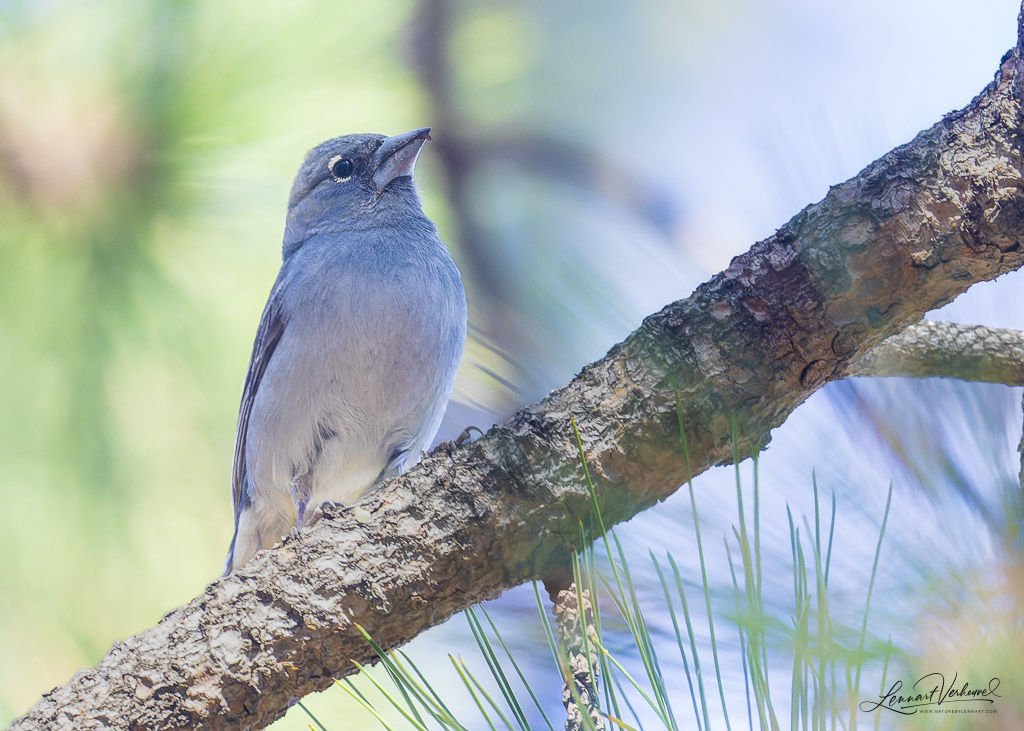
Apart from learning to freedive, I also gained a new bird species during my stay on Tenerife: the endemic Tenerife Blue Chaffinch!
Still, I found my experience on Tenerife very useful. After that, all that was left to do in the Netherlands was pay a visit to a dive shop, and I had everything I needed for a successful stay in East Timor. By then, I had also arranged everything with Desmond, and it was just a matter of waiting until East Timor would be accessible again from Bali. The reopening of Bali itself was still a hurdle. Eventually, July, August, and September passed, but flights to East Timor still hadn’t resumed. In the end, I had to make a decision: I went to Ecuador and Bolivia instead of Timor-Leste. I had a great time there too. I saw Spectacled Bears in Ecuador and the fascinating Jaguarundi in Bolivia, but I would have much preferred to have had my experience in Timor-Leste.


Instead of Blue Whales: Andean Bear in Ecuador (see more here) and Jaguarundi in Bolivia (see more here).
The following year, the situation with COVID-19 had improved significantly worldwide, and I could have gone if I hadn’t gotten a new job. My training as an attorney meant that I had commitments every October or November—the exact time when the Blue Whales were migrating! In the end, it turned out that I wouldn’t be able to go until 2024, when I was finally able to visit Timor-Leste at the right time of year.
There was just one problem: I wasn’t the only one who had taken notice of the unique experiences to be had in Timor-Leste! Desmond turned out to be quite fully booked, and spending three weeks in East Timor as I had planned seemed like too ambitious a goal. It took a long time to confirm, right up to June 2024 and by then it seemed like it wasn’t going to happen anymore. Then, I found a way to arrange a longer stay. I booked part of my stay directly with Desmond and another part through the travel agency Big Fish Expeditions, who had already made a reservation with Desmond. I was lucky that they still had exactly one spot available that aligned with the time Desmond had for me.
And so, after all that time of preparation, it was finally going to happen! First, I spent a few days in Bali. I wanted to see a few local birds, and it also ensured that I would have no issues with my flight to East Timor. But on Thursday, October 17, 2024, the moment was finally there: I landed at Dili airport. I flew with the local airline, Aero Dili.
A nice welcome was a flight of seven Little Curlews that were “flushed” by my plane and flew up from the grass next to the runway. I had only seen this species once before in the Netherlands, and it’s a very attractive wader. Unfortunately, I didn’t have a camera or binoculars with me, but the uniform brown back, combined with its size and slightly longer, curved bill, gave it away. I also noted a light window on the upper wings at the bend of the wing that contrasted with the darker primary feathers. Later, this turned out to perfectly match the picture of a Little Curlew in flight on the Merlin app. I knew Little Curlew was possible, but it didn’t seem like an everyday sighting. So, I was happy with this first species in this country!
After that, birds really took a back seat to the Blue Whales, but fortunately, I would still see some new species. I was picked up from the airport and transported by van to the dive resort. There, all the practical matters were taken care of, after which there was a bit of time to try to see a Dugong. Unfortunately, the visibility underwater at that moment was too poor. That evening, we had a festive meal with a beautiful view of the bay and the rising full moon.



Sunset above the Bay of Dili


Out on the water
In the days that followed, we worked hard to find Blue Whales. On the second day, we succeeded. Late in the afternoon, I suddenly saw a Blue Whale swimming. That was the moment we prepared to enter the water for the first time. I still clearly remember two things from that first time: a massive back that seemed to be heading straight towards me, and the frustration when I realized I could still miss the Blue Whale underwater.


First look at a Blue Whale underwater: not the kind of views I wanted!
Seeing a Blue Whale underwater turned out to be much more difficult than I had imagined. Despite the relatively good visibility underwater in this ocean, a Blue Whale didn’t have to swim too far for it to become invisible. Just a few meters could make the difference between seeing the entire whale or barely being able to spot its pale pectoral fins. That was something I would have to work on in the coming days.
It wasn’t easy because we didn’t see a Blue Whale every day. Sometimes, we would sail for hours on the ocean without a trace of a Blue Whale. Fortunately, there were other animals to keep us entertained. In particular, dolphins were always worth a second look. I really enjoyed their habit of riding the bow waves of the ship.



Dwarf Spinner Dolphins moving along with the ship. Can you spot the baby?



Dwarf Spinner Dolphins under water
Photographing dolphins “in flight” was not easy because their jumps often came at unexpected moments. Fortunately, I was able to capture a few moments successfully.

Bottlenose Dolphin







Dwarf Spinner Dolphin spinning!



Pantropical Spotted Dolphin
On dull days, the coral was also a welcome source of entertainment. We would go into the water to search for the Dugong, but that soon seemed pretty hopeless, so I always ended up spending more time among the coral. Seeing the coral was of course also very enjoyable.










Exploring the coral along the Timorese coast
A thrilling moment came when I encountered a Yellow-lipped Sea Krait underwater. This snake was moving through the water and swam up to the surface to breathe. I swam alongside it to take photos until the snake suddenly swam straight towards me while making biting motions with its mouth! I vaguely remembered reading that these snakes could be venomous, so I decided not to take any chances. I pushed the snake down with the dome port of my underwater housing. Thankfully, the snake then fled away from me.


Yellow-lipped Sea Krait
Later, when I figured out what species it was, I discovered that it was indeed the Sea Krait: a snake species that is ten times more venomous than a rattlesnake! Although these snakes are known to be very calm and rarely cause human fatalities, I was still glad I hadn’t taken any risks. Possibly the snake was feeling aggressive because it saw its own reflection in my dome port.
There was certainly plenty to experience, but in the end, it was all about one species: the Blue Whale! By the end of the first week, I had managed to take a few photos that I was happy with. For example, I already had a more artistic shot of a Blue Whale swimming beneath me, being a part of the sunbeams shining through the water.


Into a blue star!
I also had the opportunity to take some photos of a Blue Whale with other people nearby, so the scale of the animal and the experience could be more clearly seen.
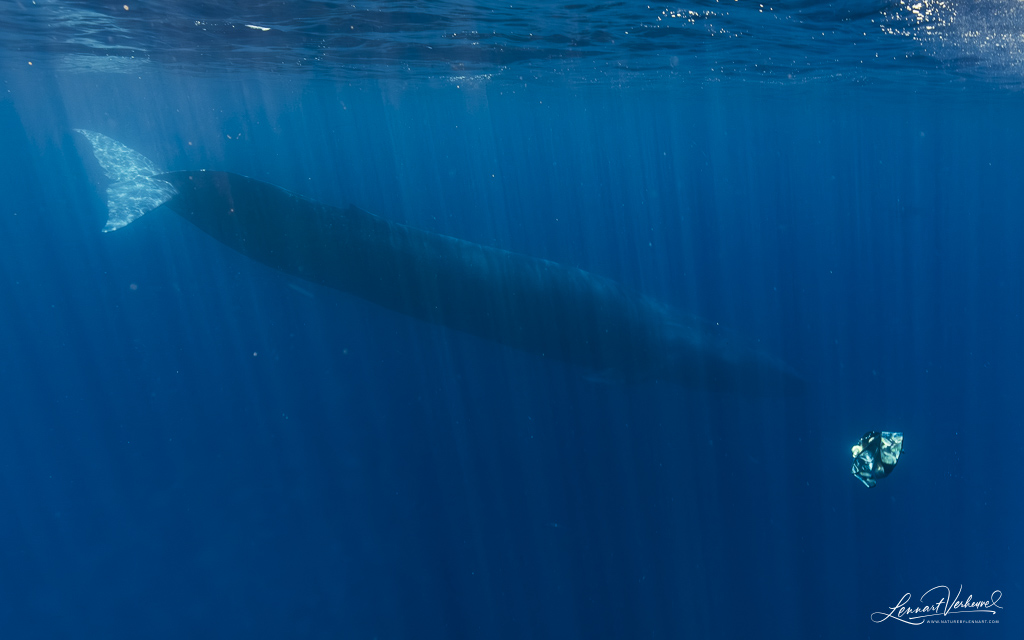



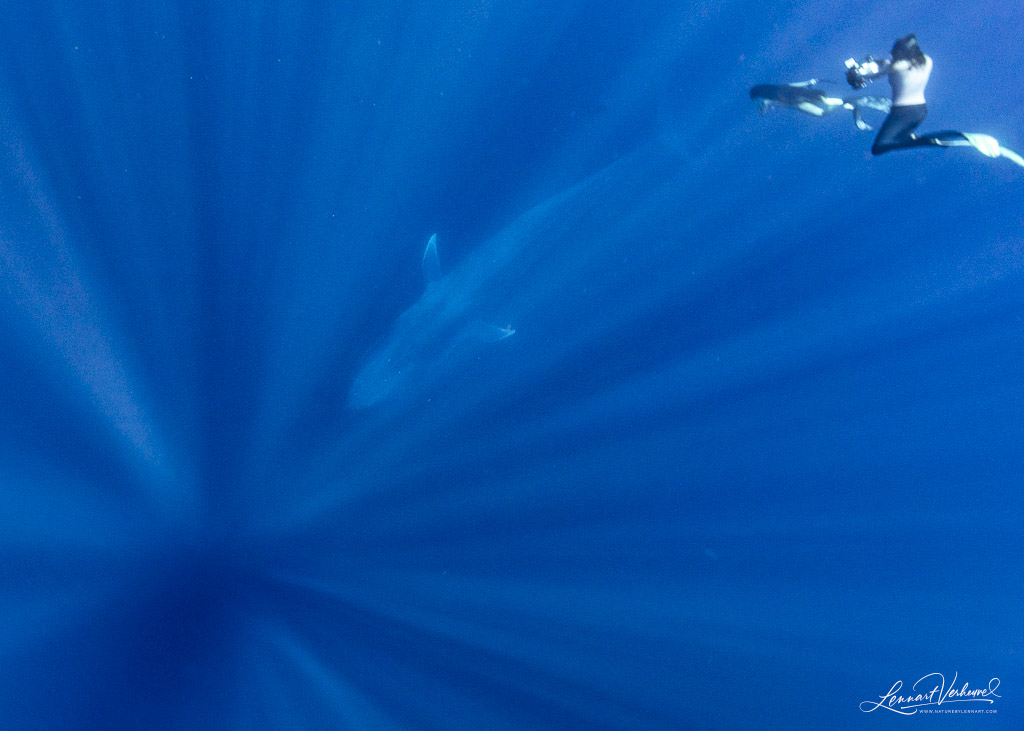
Watching a Blue Whale
But that one moment I was hoping for, where I could admire the Blue Whale in all its glory up close, I still hadn’t had. I continued to struggle with being in the right place at the right time. Although I had long freediving fins, when I swam at the surface, I was able to generate much less power with them. My underwater housing also created a lot of drag, all of which costed me too much meters!
After seven days of struggling without really good results, it started to feel a bit hopeless. I couldn’t imagine it getting much easier. I realized that these were the most difficult pictures I had ever put in an effort for. Normally, the challenge is finding the animal, and once that’s done, the good photos come naturally. But in this case, I couldn’t assume that I would be able to take good photos just because we found a Blue Whale.
That hopeless period suddenly came to an end on the eighth day. The day started off very calmly— downright boring. Slowly, we sailed eastward. The Blue Whales migrate from east to west, so speeding along could mean that we would just miss one. We kept ourselves entertained with Risso’s Dolphins. This species of dolphin has distinctive scratches on its body.


Risso’s Dolphin
While we were watching the Risso’s Dolphins, a Blue Whale was suddenly reported! We quickly got ready. As the Blue Whale approached our boat, we sailed calmly alongside it until the moment came when we could enter the water. When the signal came, we jumped into the water one after another, and then we swam!
From the water, it was difficult to see where the Blue Whale was, but it was much easier from the boat. It was important to listen carefully to the directions so we would know which way to swim. We kept our heads above water to listen. When we heard “Dive! Dive!”, that was the moment to put our heads underwater. Even better was to immediately take a deep breath and swim as deep as possible.
When I heard the “Dive! Dive! Dive!” I immediately put my head underwater. And there, very close, was a Blue Whale! Like a submarine, I saw the Blue Whale hanging in the water, and I could clearly see the “smile” formed by the specific shape of its lower and upper jaw.

Blue Whale preparing to dive
This was the sight I had worked for during those seven days, the reason I had come to Timor-Leste!
I took as many photos as possible. It turned out to be quite difficult to capture the entire animal in a shot, even though I was using a wide-angle lens, shooting at 16mm on a full-frame camera. The animal was simply too large, and I was too close to see the whole thing in one glance. I mostly saw its head, and the rest of the body followed behind. Fortunately, my camera was able to capture much more, and I was incredibly happy to finally have good photos of a Blue Whale: mission accomplished!


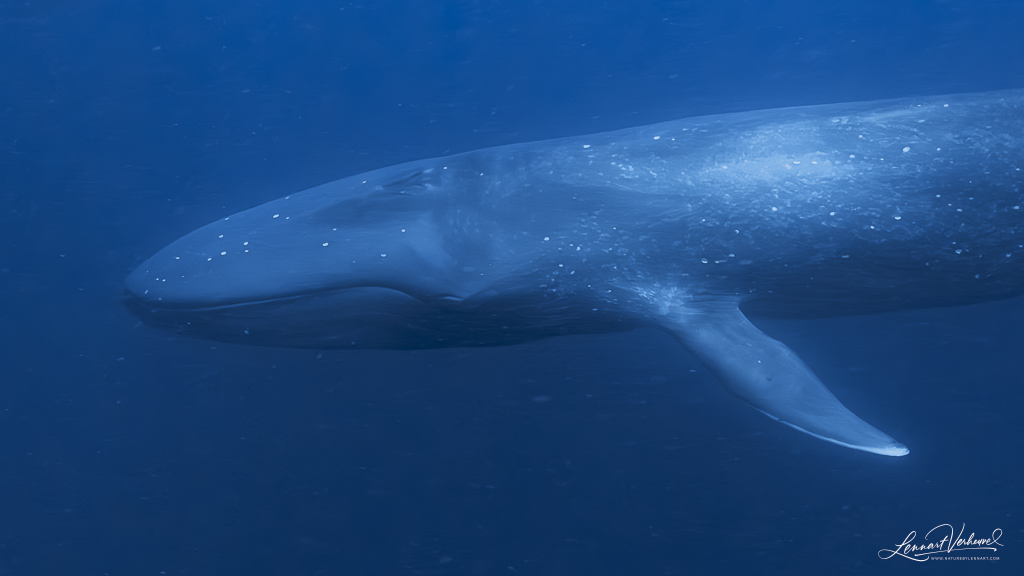


Blue Whale
When we went into the water for the second time that day, we couldn’t get as close, but I was still very pleased with my photo of the Blue Whale swimming beneath me, showing its beautiful back with the glowing spots clearly visible. The Blue Whale turned out to be a very pretty creature! Above the water, the animal appears gray, but underwater, it immediately looks blue, and the light spots on the upper jaw stand out vividly.


In a sea of stars: the beauty of a Blue Whale!
That day, I came out of the water feeling very satisfied! It felt like the curse had been broken, and I was very curious about what new experiences the second part of my trip, booked through Big Fish, would bring. I did everything I could to give myself a better starting position in the water. Thanks to some tips from Desmond, I developed a new swimming technique with my camera, which made me go much faster. I also swam in the ocean for an hour every day to train my feet to swim with the large fins and to strengthen them. It was exhausting, but all the hard work paid off!


Working on my underwater skills! (pictures by Lara Christensen)
After a day of rest, I headed back onto the water. This time with the group from Big Fish, with whom I would be traveling for the next five days. We had already gotten to know each other the day before. It was nice to set out with the same group of people for several days.
My swimming practice also paid off when I managed to observe a group of Risso’s dolphins underwater. These animals are very shy around swimmers, and the only way to see them underwater is to dive in from the boat and swim the entire distance to them underwater. On a previous attempt, I had hurt myself when I jumped into the water with my camera and accidentally hit my face with it. Without the camera, things went much better and I was able to reach them under water, though it did mean I didn’t get any photos. That didn’t make the experience any less amazing, and I was thrilled with this wonderful start!
The day got even better when we quickly found a Blue Whale and were able to follow it closely. Each time, I managed to locate the Blue Whale underwater and swim towards it, but I still didn’t get any truly great photos.
When we entered the water for the third time, I immediately saw the Blue Whale swimming again and dove after it to take pictures. While I was snapping photos, I was utterly stunned to suddenly catch sight of a second Blue Whale out of the corner of my eye—just five meters away from me! Because I was focused on the wrong Blue Whale, I had completely missed the second one, and we hadn’t known to expect another. Of course, I immediately took as many photos as I could!

Second one incoming in the upper left corner!


Blue Whale
I was even so close that I could see its eyes!

Blue Whale
I even managed to capture both of them in a single shot!

On migration together!

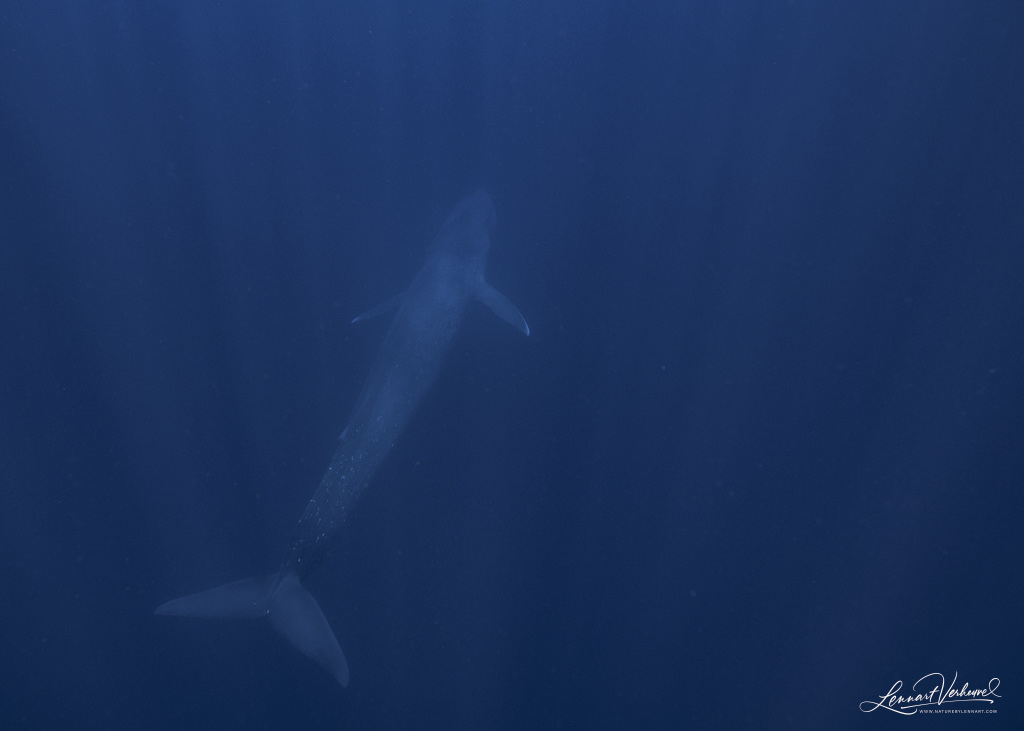
Later, I noticed on one of my other photos that I had actually captured two Blue Whales during an earlier drop as well. Amazing how we could miss such an enormous animal!

One on the left and one all the way to the right!
And so, a truly remarkable day came to an end.
The next day, Desmond lent me his Canon EF 8-15mm Fisheye lens so I could experiment with a different kind of photography. I eagerly took advantage of the opportunity, because we found another Blue Whale that day! That was going well! We had some nice moments at a reasonably close distance.



Blue Whale
The Fisheye lens captured significantly more sunbeams, creating a special effect.
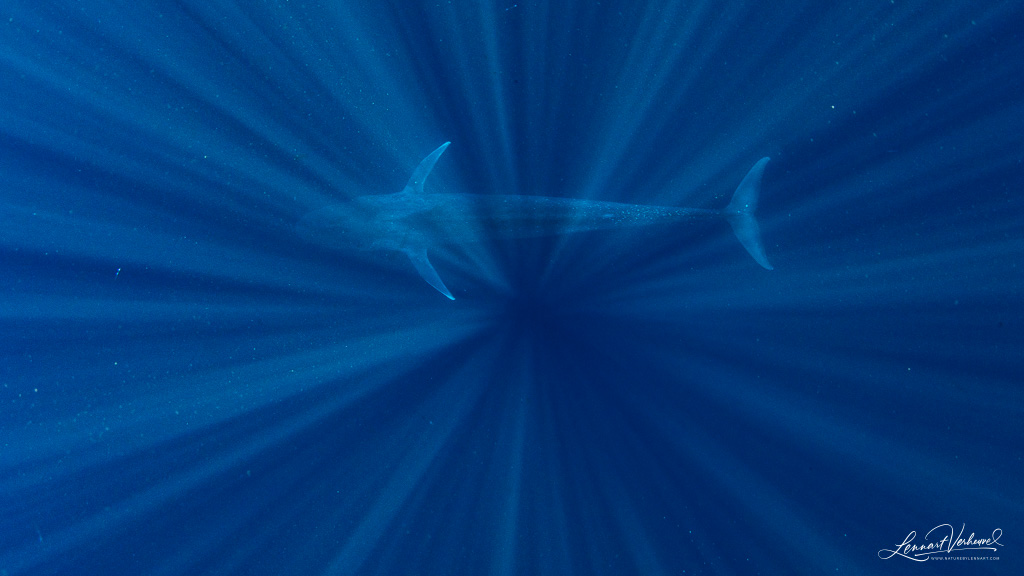
Blue Whale
The next day, I decided to switch back to my own lens because I preferred working with one that didn’t distort the image. Underwater, the distortion isn’t very noticeable, but when the water surface is in the frame, it becomes quite apparent. And I still wanted to try a so-called “split shot”!
The day started off rather frustrating. At first, we were excited because we found the first Sperm Whales of the trip! Unfortunately, they turned out to be quite shy and dove away as soon as we entered the water. That cost us a lot of time, and it started to seem like we might not see much else that day.
Then, other boats informed us they had found a Blue Whale and shared the location with us! Early in the afternoon, we headed over and encountered the slowest Blue Whale I have ever seen. Truly, this Blue Whale was exceptionally calm.
What stood out even more was how remarkably thick the whale appeared. We speculated that it might be a pregnant female, though it could just as easily have been a well-fed Blue Whale taking its time and not in any rush to continue its migration.
Anyway, this made it much easier for us to enter the water multiple times and observe this Blue Whale up close! In total, I managed to get in the water three times, and each time, I had an amazing view of the Blue Whale. Finally, I was truly eye-to-eye with the largest animal on the planet! This resulted in my best series of photos from the trip.



First drop



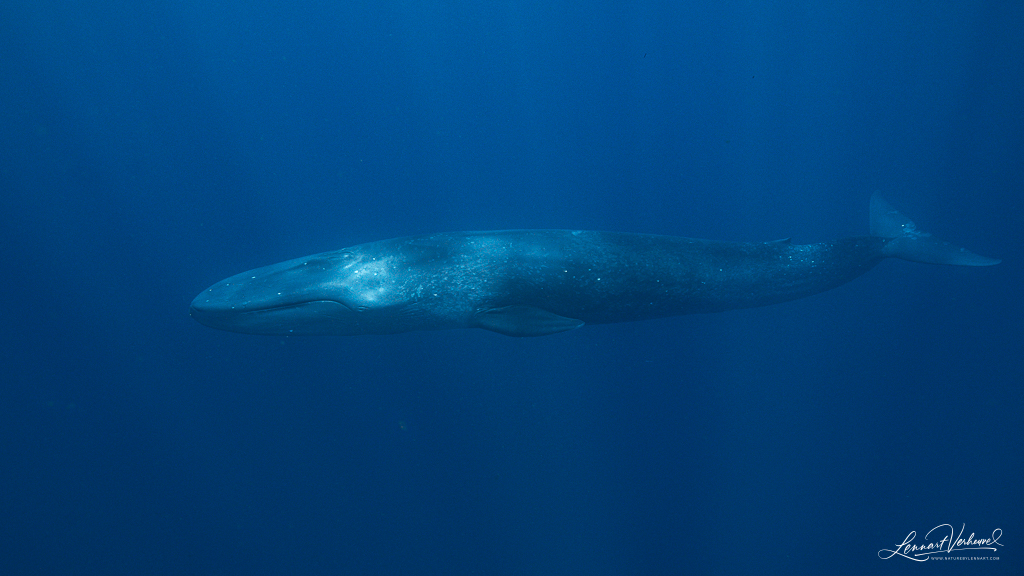

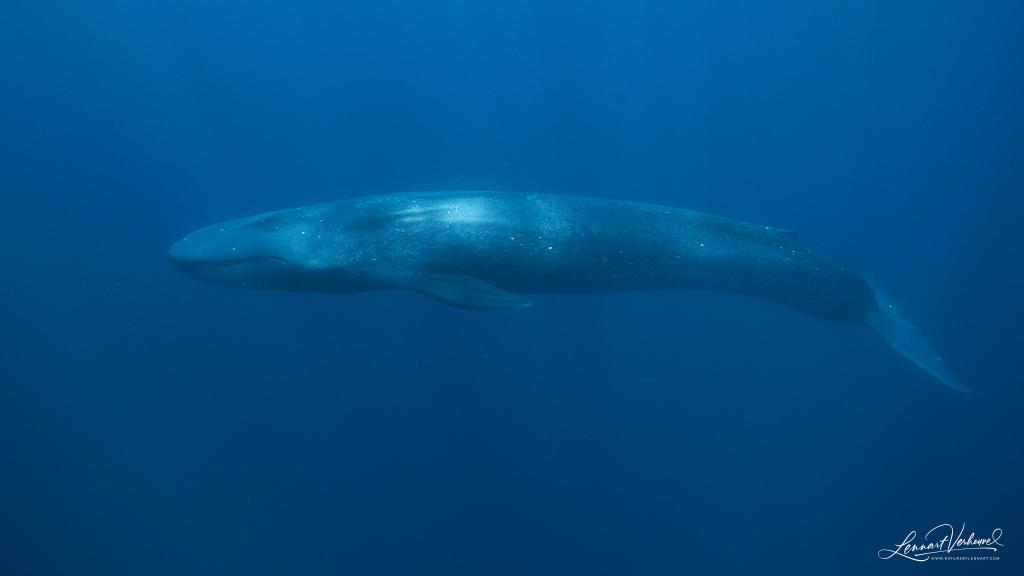

Second drop


Third drop
I was also able to film some of these underwater moments with the Blue Whale. I want to thank my travel companions Sean Magee and Barney Napier for the footage in which I appear! Watch the full video below.
Our guide from Big Fish, Jennifer Idol, also took some very cool pictures of me with the Blue Whale. That was an unexpected souvenir!


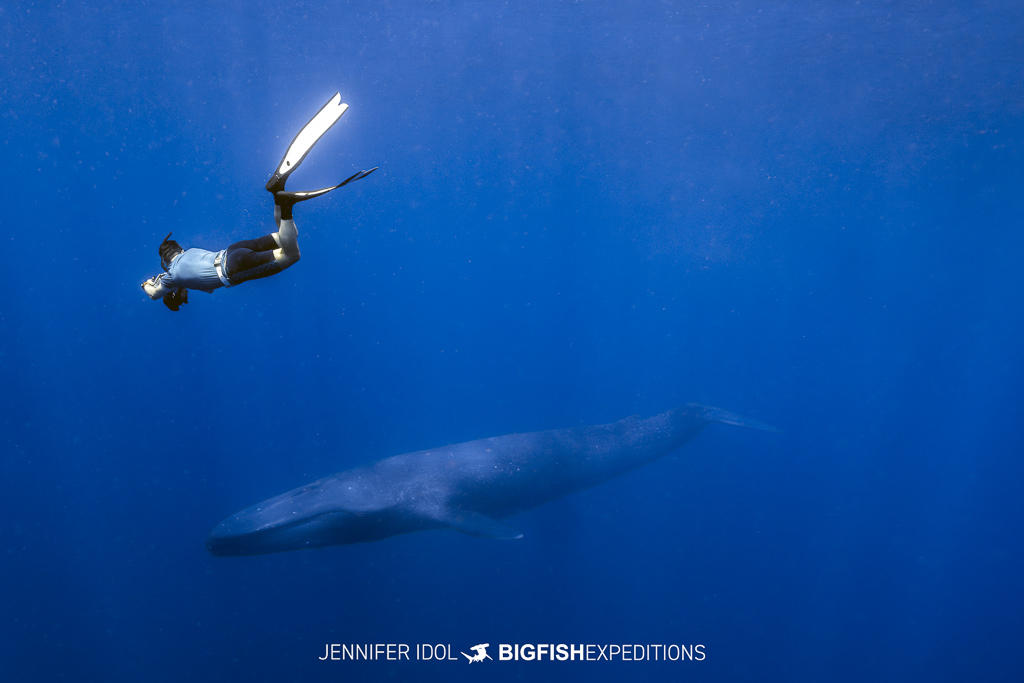
Me and a Blue Whale (pictures by Jennifer Idol)
Looking back, I know these were also my last moments with a Blue Whale underwater. In the days that followed, we didn’t encounter any more Blue Whales, and I had a few remaining days where I couldn’t join the boat trips. Instead, I spent my time exploring the beautiful coral and searching for Dugongs. After all, I still hadn’t seen one. Hopefully, I would have some luck in the remaining days!
In any case, I could look back on a successful trip. Despite all the preparations I had made, the reality turned out to be more challenging than I had expected, but in the end, it was worth putting in so much time and effort. Each day brought me closer to my goal, until the moment came when I was truly eye-to-eye with the largest animal in the world! This sighting felt like discovering a new species—it’s an experience on an entirely different level. It would be exciting to see other whales in this way as well. For now, there’s still plenty more to experience!
Want to read more about the first days in Bali? Click here!
2 comments so far
Phil KokenPosted on3:23 pm - Dec 21, 2024
Ha Lennaert, wat een prachtverhaal en dito foto’s man, helemaal geweldig! Petje af voor je voorbereidingen en doorzettingsvermogen. Ik zou advocaat-worden achter je laten en je professie hierop gaan richten 😉
Heel bijzonder!
Grt Phil
adminPosted on8:16 pm - Dec 21, 2024
Hahaha, dankjewel! Voorlopig moet het allemaal nog ergens van betaald worden helaas :).